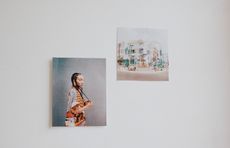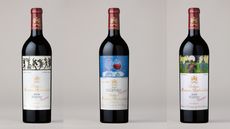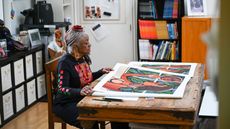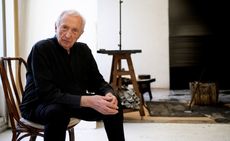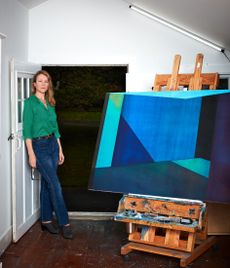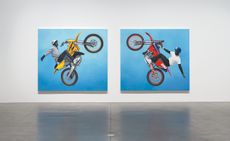Gavin Turk: ‘My art is always other people's art’
We interview British artist Gavin Turk, whose show ‘Kerze’ at Ben Brown Fine Arts is an ode to Gerhard Richter, with an uncanny twist
- (opens in new tab)
- (opens in new tab)
- (opens in new tab)
- Sign up to our newsletter Newsletter
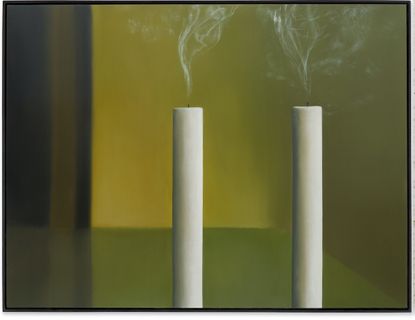
It’s been 25 years since ‘Sensation’, the 1997 landmark Royal Academy show in London that rattled the very fabric of art as we knew it. Everything was controversial, everything stirred the senses, and nothing, in British art at least, has been the same since.
One artist in the nucleus of this melting pot was Gavin Turk, a key protagonist of the YBAs (Young British Artists). Turk’s subversive visual identity has long been defined by ‘quoting’ ingredients from other artists or sources and fusing them with his own. The resulting recipe is a provocative blend that questions core notions of authorship and value. ‘My art is always other people's art,’ he says. ‘But I'd also say that the inevitability of contemporary art is that it's always a self-portrait as well.’

Gavin Turk
Among his most recognisable hits are Pop (1993), a waxwork figure of Turk as Sid Vicious posing as Andy Warhol's Elvis Presley, which appeared as one of the headline works in ‘Sensation’; Pile (2004), a hyperreal ensemble of bronze-cast bin bags; and more recently, a curious homage to Piero Manzoni in Artist’s Piss (2021), a series of aluminium cans filled with, well, the title covers that.
On the face of it, ‘Kerze’, at London’s Ben Brown Fine Arts, seems devoid of the electric-shock factor for which Turk is known. ‘Normally my works are humorous’, he says, walking me around the exhibition in November. ‘I had an idea that there might be some humour in the unexpectedness of this as a show by me. It makes you laugh because it's a bit off-key.’ In that sense, it is very Turk indeed; but we must look harder, and deeper. He is, after all, an artist for which we’re conditioned to expect the unexpected.

Installation view of 'Kerze' by Gavin Turk

Installation view of 'Kerze' by Gavin Turk
Turk has transformed the gallery into something akin to a chapel. Eleven canvases of meticulously painted candles (some solitary, some paired or in threes) are set against eerie, hazily-lit modernist backgrounds. Focus on one painting, and another in your peripheral vision appears to billow in the gallery’s slow wind.
The London art exhibition is something of a quote within a quote. Turk first came across Kerze (Candle), a 1983 painting by Gerhard Richter, on the cover of Sonic Youth’s 1988 album, Daydream Nation. And it’s been lodged in his subconscious ever since. ‘I think I was a bit of a daydreamer, and that's probably why I ended up being an artist,’ Turk reflects. ‘At the time, there was still energy between the image and the music. It was still significant to be able to have the music and a picture to look at.’
‘I conceived of them quite conceptually, like a sculpture,' he says ‘It’s about paring it down and really going for the minimal thing and just seeing how that feels or how it works.’
There is one obvious distinction between the two artists’ take on ‘Kerze’: Richter’s candle is lit, Turk’s are extinguished. While Turk describes Richter’s work as having ‘the energy of now’, his own paintings suggest the immediate aftermath of human presence, as the candle breathing the death rattle of its combustion.
A candle, in the 21st century, is a relatively superfluous addition to daily life, symbolising occasion, sacredness, mourning and celebration. Turk’s paintings seem to dwell on the afterthought, each with a lingering question mark.

Gavin Turk
Turk has often mined from the toolbox of Surrealism, his work featuring eggs, pipes, doors, windows, candles, and smoke. ‘I keep talking about [the candles] as metaphysical symbols. ‘They appear and reappear in Surrealism. They're almost like a clock, then they disappear into the air like a ghost,’ he says. Surrealism yes, but also antiquity; the extinguished candle, after all, is a well-oiled memento mori.
Gavin Turk’s ‘Kerze’ is a show of many sensations. There’s a lure of familiarity, dashed by a simple yet fundamental intervention; melancholy and nostalgia for moments just passed; a daydream floats above a hyperreality, and a puff of subtle, but characteristically subversive humour.
Gavin Turk, ‘Kerze’, until 14 January 2023, Ben Brown FIne Arts, London. benbrownfinearts.com (opens in new tab)
Harriet Lloyd-Smith is the Arts Editor of Wallpaper*, responsible for the art pages across digital and print, including profiles, exhibition reviews, and contemporary art collaborations. She started at Wallpaper* in 2017 and has written for leading contemporary art publications, auction houses and arts charities, and lectured on review writing and art journalism. When she’s not writing about art, she’s making her own.
-
 Last chance to see: Sterling Ruby’s ‘Turbines’ at Gagosian New York, marked here by our visit to the artist’s LA studio
Last chance to see: Sterling Ruby’s ‘Turbines’ at Gagosian New York, marked here by our visit to the artist’s LA studioStep inside American artist Sterling Ruby’s studio, divided into distinct areas of operation
By Hunter Drohojowska-Philp • Published
-
 The Fendi factory in Tuscany disappears into the landscape
The Fendi factory in Tuscany disappears into the landscapeThe new Fendi Factory in Italy, set in the rolling hills of Tuscany, is the brainchild of Milan architecture studio Piuarch and the luxury brand
By Ellie Stathaki • Published
-
 Senegal’s Mamy Tall on city planning, bioclimatic construction and heritage
Senegal’s Mamy Tall on city planning, bioclimatic construction and heritageMamy Tall from Senegal is part of our series of profiles of architects, spatial designers and builders shaping West Africa's architectural future
By Ellie Stathaki • Published
-
 London art exhibitions: a guide for this week
London art exhibitions: a guide for this weekYour guide to the best London art exhibitions, and those around the UK, as chosen by the Wallpaper* arts desk
By Harriet Lloyd Smith • Last updated
-
 An art history of Château Mouton Rothschild wine labels, from Lucian Freud and Niki de Saint Phalle to Peter Doig
An art history of Château Mouton Rothschild wine labels, from Lucian Freud and Niki de Saint Phalle to Peter DoigWe take a closer look at Château Mouton Rothschild’s 2020 vintage label designed by artist Peter Doig and look back on the house’s fruitful history of artist collaborations
By Harriet Lloyd-Smith • Last updated
-
 Faith Ringgold on capturing the complexity of the American experience: ‘It takes courage to be free’
Faith Ringgold on capturing the complexity of the American experience: ‘It takes courage to be free’We interview Faith Ringgold, whose major retrospective exhibition ‘American People’ runs until 27 November at the de Young Musuem, San Francisco
By Aindrea Emelife • Published
-
 Rashid Johnson in Menorca: a journey through migration, longing and togetherness
Rashid Johnson in Menorca: a journey through migration, longing and togethernessWe visited Rashid Johnson’s Brooklyn studio ahead of the artist’s show at Hauser & Wirth Menorca, which contemplates drift – physical and emotional
By Osman Can Yerebakan • Published
-
 Remembering Pierre Soulages (1919-2022), a pioneer of post-war abstraction
Remembering Pierre Soulages (1919-2022), a pioneer of post-war abstractionPierre Soulages, the pioneering French printmaker, sculptor and ‘painter of black’, has died aged 102
By Diane Theunissen • Published
-
 Artist Karin Schaefer blends divine order and queer joy with hard-edged geometry
Artist Karin Schaefer blends divine order and queer joy with hard-edged geometryWe explore the life, work and Massachusetts studio of American artist Karin Schaefer, ahead of her solo show ‘Continuum’ at Sears Peyton Gallery, New York
By Michael Reynolds • Last updated
-
 Amy Sherald’s vivid, triumphant portraits reframe Black personhood in Western art
Amy Sherald’s vivid, triumphant portraits reframe Black personhood in Western artIn ‘The World We Make’ at Hauser & Wirth London (until 23 December), American painter Amy Sherald raises critical questions about the position of Black bodies in Western art
By Elisha Tawe • Last updated
-
 Tracey Emin interview: ‘If I hadn’t made art, I would be dead by now’
Tracey Emin interview: ‘If I hadn’t made art, I would be dead by now’We speak to British artist Tracey Emin in her hometown of Margate, where she has created a new painting to raise funds for TKE Studios, a pioneering complex serving the next generation of radical creatives. ‘I don’t want to die being an artist that made really interesting work. I want to make a future.’
By Sheila Lam • Last updated


